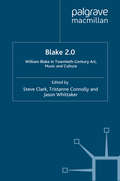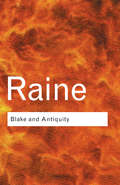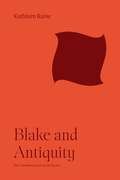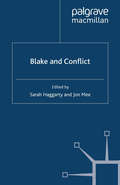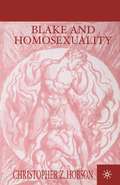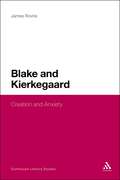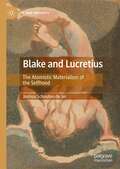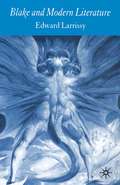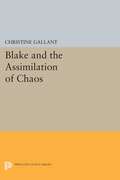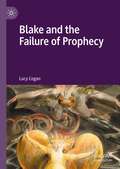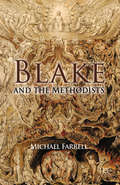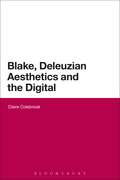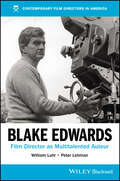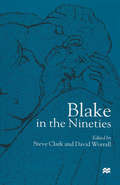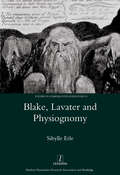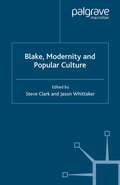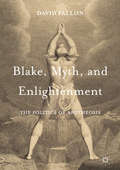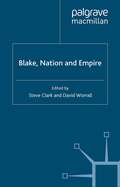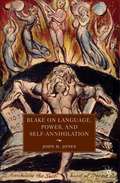- Table View
- List View
Blake 2.0: William Blake in Twentieth-Century Art, Music and Culture
by Steve Clark, Tristanne Connolly and Jason WhittakerBlake said of his works, 'Tho' I call them Mine I know they are not Mine'. So who owns Blake? Blake has always been more than words on a page. This volume takes Blake 2.0 as an interactive concept, examining digital dissemination of his works and reinvention by artists, writers, musicians, and filmmakers across a variety of twentieth-century media.
Blake and Antiquity
by Kathleen RaineBlake was a visionary like no other. To some, like William Wordsworth, the only explanation for the remarkable spiritual world Blake witnessed and brought to life in his books was 'insane genius'. Although such a view persisted well into the twentieth century, this is the pivotal work which challenged that perspective and changed forever our understanding of William Blake's genius, placing him in the esoteric tradition. For many this book will be a revelation; for lovers of Blake it is indispensable.
Blake and Antiquity
by Kathleen RaineBlake was a visionary like no other. To some, like William Wordsworth, the only explanation for the remarkable spiritual world Blake witnessed and brought to life in his books was 'insane genius'. Although such a view persisted well into the twentieth century, this is the pivotal work which challenged that perspective and changed forever our understanding of William Blake's genius, placing him in the esoteric tradition. For many this book will be a revelation; for lovers of Blake it is indispensable.
Blake and Antiquity (The A. W. Mellon Lectures in the Fine Arts #11)
by Kathleen RaineThe classic book on William Blake as prophet of the New AgeWilliam Blake (1757–1827) inhabited a remarkable inner world, one that he brought vividly to life in his poetry, painting, and printmaking. Blake and Antiquity situates this brilliant and enigmatic artist within the Western esoteric canon, revealing his indebtedness to Neoplatonism, the Gnostics, alchemy, and astrology. In this book, Kathleen Raine demonstrates how Blake rejected conventional orthodoxy and went in search among the occult traditions of antiquity for symbols that might expand the mind’s awareness into a spiritual state where space, time, and even death are transcended.
Blake and Conflict
by S. Haggarty J. MeeFamously, Blake believed that 'without contraries' there could be no 'progression'. Conflict was integral to his artistic vision, and his style, but it had more to do with critical engagement than any urge to victory. The essays in this volume look at conflict as it marked Blake's thinking on politics, religion and the visual arts.
Blake and Homosexuality
by C. HobsonAgainst the backdrop of Britain's underground 18th and early-19th century homosexual culture, mob persecutions, and executions of homosexuals, Hobson shows how Blake's hatred of sexual and religious hypocrisy and state repression, and his revolutionary social vision, led him gradually to accept homosexuality as an integral part of human sexuality. In the process, Blake rejected the antihomosexual bias of British radical tradition, revised his idealization of aggressive male heterosexuality and his male-centered view of gender, and refined his conception of the cooperative commonwealth.
Blake and Kierkegaard: Creation and Anxiety (Continuum Literary Studies)
by James RoviraThis study applies Kierkegaardian anxiety to Blake's creation myths to explain how Romantic era creation narratives are a reaction to Enlightenment models of personality.
Blake and Lucretius: The Atomistic Materialism of the Selfhood (The New Antiquity)
by Joshua Schouten de JelThis book demonstrates the way in which William Blake aligned his idiosyncratic concept of the Selfhood – the lens through which the despiritualised subject beholds the material world – with the atomistic materialism of the Epicurean school as it was transmitted through the first-century BC Roman poet and philosopher Lucretius’ De Rerum Natura. By addressing this philosophical debt, this study sets out a threefold re-evaluation of Blake’s work: to clarify the classical stream of Blake’s philosophical heritage through Lucretius; to return Blake to his historical moment, a thirty-year period from 1790 to 1820 which has been described as the second Lucretian moment in England; and to employ a new exegetical model for understanding the phenomenological parameters and epistemological frameworks of Blake’s mythopoeia. Accordingly, it is revealed that Blake was not only aware of classical atomistic cosmogony and sense-based epistemology but that he systematically mapped postlapsarian existence onto an Epicurean framework.
Blake and Modern Literature
by E. LarrissyWilliam Blake is one of the most important influences on twentieth-century literature. This study will ask why he is a figure central to the Modernist re-definition of past art. He also appears to be an acceptable sage for postmodernists, he can be associated with an opposition to authority without imposing one version of his own mythology.
Blake and the Assimilation of Chaos
by Christine GallantIn all of his works Blake struggled with the question of how chaos can be assimilated into imaginative order. Blake's own answer changed in the course of his poetic career. Christine Gallant contends that during the ten year period of composition of Blake's first comprehensive epic, The Four Zoas, Blake's myth expanded from a closed, static system to an open, dynamic process. She further argues that it is only through attention to the changing pattern of Jungian archetypes in the poem that one can discern this profound change. Using the depth psychology of Jung, Professor Gallant presents a comprehensive interpretation of Blake's poetry from his early "Lambeth" prophecies to his mature works, The Four Zoas, Milton, and Jerusalem. She offers a Jungian critical approach that respects the work's autonomy, but still suggests how literature is an ongoing imaginative experience in which archetypal symbols affect their literary contexts. What interests the author is the function that the very process of mythmaking had for Blake. Professor Gallant finds that the metaphysical opposition between God and Satan in Blake's earlier work gradually evolves into an interplay of these powers in the later works. The quality of Chaos changes for Blake from something unknown and feared, contrary to Order, to something intimately known and embraced.Originally published in 1979.The Princeton Legacy Library uses the latest print-on-demand technology to again make available previously out-of-print books from the distinguished backlist of Princeton University Press. These editions preserve the original texts of these important books while presenting them in durable paperback and hardcover editions. The goal of the Princeton Legacy Library is to vastly increase access to the rich scholarly heritage found in the thousands of books published by Princeton University Press since its founding in 1905.
Blake and the Failure of Prophecy
by Lucy CoganThis monograph reorients discussion of Blake’s prophetic mode, revealing it to be not a system in any formal sense, but a dynamic, human response to an era of momentous historical change when the future Blake had foreseen and the reality he was faced with could not be reconciled. At every stage, Blake’s writing confronts the central problem of all politically minded literature: how texts can become action. Yet he presents us with no single or, indeed, conclusive answer to this question and in this sense it can be said that he fails. Blake, however, never stopped searching for a way that prophecy might be made to live up to its promise in the present. The twentieth-century hermeneuticist Paul Ricoeur shared with Blake a preoccupation with the relationship between time, text and action. Ricoeur’s hermeneutics thus provide a fresh theoretical framework through which to analyse Blake’s attempts to fulfil his prophetic purpose.
Blake and the Methodists
by M. FarrellExploring the work of William Blake within the context of Methodism – the largest 'dissenting' religious group during his lifetime – this book contributes to ongoing critical debates surrounding Blake's religious affinities by suggesting that, contrary to previous thinking, Blake held sympathies with certain aspects of Methodism.
Blake, Deleuzian Aesthetics, and the Digital (Continuum Literary Studies)
by Claire ColebrookDrawing on recent theories of digital media and on the materiality of words and images, this fascinating study makes three original claims about the work of William Blake. First, Blake offers a critique of digital media. His poetry and method of illuminated printing is directed towards uncovering an analogical language. Second, Blake's work can be read as a performative. Finally, Blake's work is at one and the same time immanent and transcendent, aiming to return all forms of divinity and the sacred to the human imagination, stressing that 'all deities reside in the human breast,' but it also stresses that the human has powers or potentials that transcend experience and judgement: deities reside in the human breast. These three claims are explored through the concept of incarnation: the incarnation of ideas in words and images, the incarnation of words in material books and their copies, the incarnation of human actions and events in bodies, and the incarnation of spirit in matter.
Blake, Deleuzian Aesthetics, and the Digital (Continuum Literary Studies)
by Claire ColebrookDrawing on recent theories of digital media and on the materiality of words and images, this fascinating study makes three original claims about the work of William Blake. First, Blake offers a critique of digital media. His poetry and method of illuminated printing is directed towards uncovering an analogical language. Second, Blake's work can be read as a performative. Finally, Blake's work is at one and the same time immanent and transcendent, aiming to return all forms of divinity and the sacred to the human imagination, stressing that 'all deities reside in the human breast,' but it also stresses that the human has powers or potentials that transcend experience and judgement: deities reside in the human breast. These three claims are explored through the concept of incarnation: the incarnation of ideas in words and images, the incarnation of words in material books and their copies, the incarnation of human actions and events in bodies, and the incarnation of spirit in matter.
Blake Edwards: Film Director as Multitalented Auteur (Film Directors in America)
by William Luhr Peter LehmanBLAKE EDWARDS Blake Edwards: Film Director as Multitalented Auteur is the first critical analysis to focus on the dramatic works of Blake Edwards. Best known for successful comedies such as The Pink Panther series with Peter Sellers, Blake Edwards wrote, produced, and directed serious works in radio, television, film, and theater for seven decades. Although hit films such as Breakfast at Tiffany’s and ‘10’ remain popular, many of Edwards’s dramas have been forgotten or marginalized. In this unique book, William Luhr and Peter Lehman draw on original research from numerous set visits and personal interviews with Edwards and many of his creative and business collaborators to explore his dramas, radio and television work, theatrical productions, one-man art shows, and unproduced screenplays. In-depth chapters analyze non-comedic films including Experiment in Terror, Days of Wine and Roses, and The Tamarind Seed, the theatrical feature film Gunn and the made-for-television film Peter Gunn, the musical adaptation of Victor/Victoria, and lesser-known films written but not directed by Edwards, such as Drive a Crooked Road. Throughout the book, the authors apply contemporary film theory to auteur criticism of different works while sharing original insights into how Edwards worked creatively in disparate genres and media using composition, editing, sound, and visual motifs to shape his films and radio and television series. A one-of-a-kind examination of one of the most influential film directors of his generation, Blake Edwards: Film Director as Multitalented Auteur is an excellent supplementary text for university courses in American cinema, genres, auteurs, and film criticism, and a must-read for critics, scholars, and general readers interested in the works of Blake Edwards.
Blake Edwards: Film Director as Multitalented Auteur (Film Directors in America)
by William Luhr Peter LehmanBLAKE EDWARDS Blake Edwards: Film Director as Multitalented Auteur is the first critical analysis to focus on the dramatic works of Blake Edwards. Best known for successful comedies such as The Pink Panther series with Peter Sellers, Blake Edwards wrote, produced, and directed serious works in radio, television, film, and theater for seven decades. Although hit films such as Breakfast at Tiffany’s and ‘10’ remain popular, many of Edwards’s dramas have been forgotten or marginalized. In this unique book, William Luhr and Peter Lehman draw on original research from numerous set visits and personal interviews with Edwards and many of his creative and business collaborators to explore his dramas, radio and television work, theatrical productions, one-man art shows, and unproduced screenplays. In-depth chapters analyze non-comedic films including Experiment in Terror, Days of Wine and Roses, and The Tamarind Seed, the theatrical feature film Gunn and the made-for-television film Peter Gunn, the musical adaptation of Victor/Victoria, and lesser-known films written but not directed by Edwards, such as Drive a Crooked Road. Throughout the book, the authors apply contemporary film theory to auteur criticism of different works while sharing original insights into how Edwards worked creatively in disparate genres and media using composition, editing, sound, and visual motifs to shape his films and radio and television series. A one-of-a-kind examination of one of the most influential film directors of his generation, Blake Edwards: Film Director as Multitalented Auteur is an excellent supplementary text for university courses in American cinema, genres, auteurs, and film criticism, and a must-read for critics, scholars, and general readers interested in the works of Blake Edwards.
Blake, Gender and Culture ("The Body, Gender and Culture")
by Helen P BruderBlake's combination of verse and design invites interdisciplinary study. The essays in this collection approach his work from a variety of perspectives including masculinity, performance, plant biology, empire, politics and sexuality.
Blake, Gender and Culture ("The Body, Gender and Culture" #10)
by Helen P BruderBlake's combination of verse and design invites interdisciplinary study. The essays in this collection approach his work from a variety of perspectives including masculinity, performance, plant biology, empire, politics and sexuality.
Blake in the Nineties
by Steve Clark David WorrallThe 1990s have witnessed a major reassessment of Blake initiated by a new and more rigorous comprehension of his modes of production, which in turn has led to re-evaluation of other literary and cultural contexts for his work. Blake in the Nineties grapples with the implications of the new bibliography for Blake studies, in its editorial, interpretative, and historical dimensions. As well as providing an international overview of recent Blake criticism, the collection contributes to current debates in a variety of disciplines dealing with the Romantic period, including art history, counter-Enlightenment-scholarship, theology and hermeneutic theory.
Blake, Lavater, and Physiognomy
by Sibylle Erle"William Blake never travelled to the continent, yet his creation myth is far more European than has ever been acknowledged. The painter Henry Fuseli introduced Blake to traditional European thinking, and Blake responded to late 18th century body-theory in his Urizen books (1794-95), which emerged from his professional work as a copy-engraver on Henry Hunter's translation of Johann Caspar Lavater's Essays on Physiognomy (1789-98). Lavater's work contains hundreds of portraits and their physiognomical readings. Blake, Fuseli, Joshua Reynolds and their contemporaries took a keen interest in the ideas behind physiognomy in their search for the right balance between good likeness and type in portraits. Blake, Lavater, and Physiognomy demonstrates how the problems occurring during the production of the Hunter translation resonate in Blake's treatment of the Genesis story. Blake takes us back to the creation of the human body, and interrogates the idea that 'God created man after his own likeness.' He introduces the 'Net of Religion', a device which presses the human form into material shape, giving it personality and identity. As Erle shows, Blake's startlingly original take on the creation myth is informed by Lavater's pursuit of physiognomy: the search for divine likeness, traced in the faces of their contemporary men."
Blake, Lavater, and Physiognomy
by Sibylle Erle"William Blake never travelled to the continent, yet his creation myth is far more European than has ever been acknowledged. The painter Henry Fuseli introduced Blake to traditional European thinking, and Blake responded to late 18th century body-theory in his Urizen books (1794-95), which emerged from his professional work as a copy-engraver on Henry Hunter's translation of Johann Caspar Lavater's Essays on Physiognomy (1789-98). Lavater's work contains hundreds of portraits and their physiognomical readings. Blake, Fuseli, Joshua Reynolds and their contemporaries took a keen interest in the ideas behind physiognomy in their search for the right balance between good likeness and type in portraits. Blake, Lavater, and Physiognomy demonstrates how the problems occurring during the production of the Hunter translation resonate in Blake's treatment of the Genesis story. Blake takes us back to the creation of the human body, and interrogates the idea that 'God created man after his own likeness.' He introduces the 'Net of Religion', a device which presses the human form into material shape, giving it personality and identity. As Erle shows, Blake's startlingly original take on the creation myth is informed by Lavater's pursuit of physiognomy: the search for divine likeness, traced in the faces of their contemporary men."
Blake, Modernity and Popular Culture
by S. Clark J. WhittakerThis book explores the ways in which Blake reacted to the subcultures of his day, as well as how he has inspired popular, modernist and postmodernist figures until the present day. Blake's influence on later generations of writers and artists is more important than ever, extending into film, psychology, children's literature and graphic novels.
Blake, Myth, and Enlightenment: The Politics of Apotheosis
by David FallonThis book provides compelling new readings of William Blake’s poetry and art, including the first sustained account of his visionary paintings of Pitt and Nelson. It focuses on the recurrent motif of apotheosis, both as a figure of political authority to be demystified but also as an image of utopian possibility. It reevaluates Blake’s relationship to Enlightenment thought, myth, religion, and politics, from The French Revolution to Jerusalem and The Laocoön. The book combines careful attention to cultural and historical contexts with close readings of the texts and designs, providing an innovative account of Blake’s creative transformations of Enlightenment, classical, and Christian thought.
Blake, Nation and Empire
by D. Worrall S. ClarkThis book examines Blake's work in the context of discourses of nation and empire, of the construction of a public sphere, and restores the longevity to his artistic career by placing emphasis on his work in the 1820s. Relevant contexts include technology, sentimentalism, Ireland and Catholic Emancipation, missionary prospectuses and body politics.
Blake on Language, Power, and Self-Annihilation
by J. JonesAgainst a historical backdrop that includes eighteenth-century language theory, children's literature and education, debates on the French Revolution, Biblical interpretation, and print culture, Blake on Language, Power, and Self-Annihilation breaks new ground in the study of William Blake. This book analyzes the concept of self-annihilation in Blake s work, using the language theories of Mikhail Bakhtin to elucidate the ways in which his discourse was open to the viewpoints of others, undermines institutional authority, and restores dialogue. This book not only uncovers the importance of self-annihilation to Blake's thinking about language and communication, but it also develops its centrality to Blake's poetic practice.
